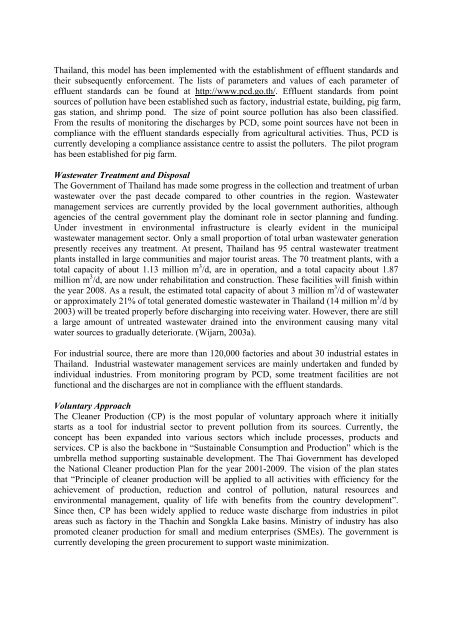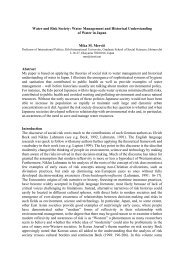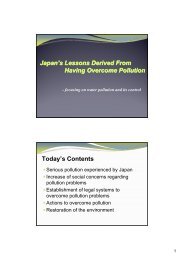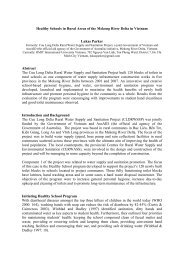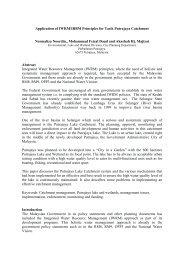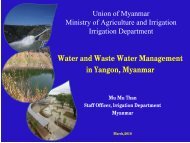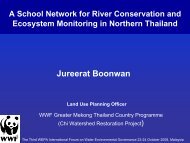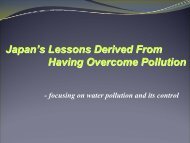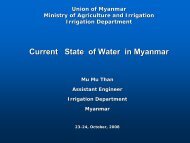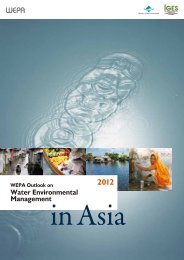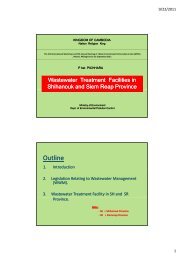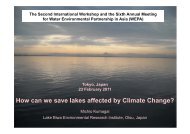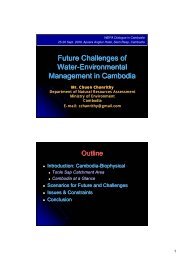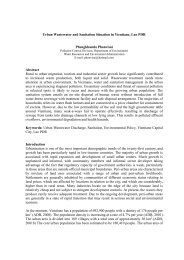Policy and Implementation on Water Environment in Thailand Wijarn ...
Policy and Implementation on Water Environment in Thailand Wijarn ...
Policy and Implementation on Water Environment in Thailand Wijarn ...
Create successful ePaper yourself
Turn your PDF publications into a flip-book with our unique Google optimized e-Paper software.
Thail<str<strong>on</strong>g>and</str<strong>on</strong>g>, this model has been implemented with the establishment of effluent st<str<strong>on</strong>g>and</str<strong>on</strong>g>ards <str<strong>on</strong>g>and</str<strong>on</strong>g><br />
their subsequently enforcement. The lists of parameters <str<strong>on</strong>g>and</str<strong>on</strong>g> values of each parameter of<br />
effluent st<str<strong>on</strong>g>and</str<strong>on</strong>g>ards can be found at http://www.pcd.go.th/. Effluent st<str<strong>on</strong>g>and</str<strong>on</strong>g>ards from po<strong>in</strong>t<br />
sources of polluti<strong>on</strong> have been established such as factory, <strong>in</strong>dustrial estate, build<strong>in</strong>g, pig farm,<br />
gas stati<strong>on</strong>, <str<strong>on</strong>g>and</str<strong>on</strong>g> shrimp p<strong>on</strong>d. The size of po<strong>in</strong>t source polluti<strong>on</strong> has also been classified.<br />
From the results of m<strong>on</strong>itor<strong>in</strong>g the discharges by PCD, some po<strong>in</strong>t sources have not been <strong>in</strong><br />
compliance with the effluent st<str<strong>on</strong>g>and</str<strong>on</strong>g>ards especially from agricultural activities. Thus, PCD is<br />
currently develop<strong>in</strong>g a compliance assistance centre to assist the polluters. The pilot program<br />
has been established for pig farm.<br />
Wastewater Treatment <str<strong>on</strong>g>and</str<strong>on</strong>g> Disposal<br />
The Government of Thail<str<strong>on</strong>g>and</str<strong>on</strong>g> has made some progress <strong>in</strong> the collecti<strong>on</strong> <str<strong>on</strong>g>and</str<strong>on</strong>g> treatment of urban<br />
wastewater over the past decade compared to other countries <strong>in</strong> the regi<strong>on</strong>. Wastewater<br />
management services are currently provided by the local government authorities, although<br />
agencies of the central government play the dom<strong>in</strong>ant role <strong>in</strong> sector plann<strong>in</strong>g <str<strong>on</strong>g>and</str<strong>on</strong>g> fund<strong>in</strong>g.<br />
Under <strong>in</strong>vestment <strong>in</strong> envir<strong>on</strong>mental <strong>in</strong>frastructure is clearly evident <strong>in</strong> the municipal<br />
wastewater management sector. Only a small proporti<strong>on</strong> of total urban wastewater generati<strong>on</strong><br />
presently receives any treatment. At present, Thail<str<strong>on</strong>g>and</str<strong>on</strong>g> has 95 central wastewater treatment<br />
plants <strong>in</strong>stalled <strong>in</strong> large communities <str<strong>on</strong>g>and</str<strong>on</strong>g> major tourist areas. The 70 treatment plants, with a<br />
total capacity of about 1.13 milli<strong>on</strong> m 3 /d, are <strong>in</strong> operati<strong>on</strong>, <str<strong>on</strong>g>and</str<strong>on</strong>g> a total capacity about 1.87<br />
milli<strong>on</strong> m 3 /d, are now under rehabilitati<strong>on</strong> <str<strong>on</strong>g>and</str<strong>on</strong>g> c<strong>on</strong>structi<strong>on</strong>. These facilities will f<strong>in</strong>ish with<strong>in</strong><br />
the year 2008. As a result, the estimated total capacity of about 3 milli<strong>on</strong> m 3 /d of wastewater<br />
or approximately 21% of total generated domestic wastewater <strong>in</strong> Thail<str<strong>on</strong>g>and</str<strong>on</strong>g> (14 milli<strong>on</strong> m 3 /d by<br />
2003) will be treated properly before discharg<strong>in</strong>g <strong>in</strong>to receiv<strong>in</strong>g water. However, there are still<br />
a large amount of untreated wastewater dra<strong>in</strong>ed <strong>in</strong>to the envir<strong>on</strong>ment caus<strong>in</strong>g many vital<br />
water sources to gradually deteriorate. (<strong>Wijarn</strong>, 2003a).<br />
For <strong>in</strong>dustrial source, there are more than 120,000 factories <str<strong>on</strong>g>and</str<strong>on</strong>g> about 30 <strong>in</strong>dustrial estates <strong>in</strong><br />
Thail<str<strong>on</strong>g>and</str<strong>on</strong>g>. Industrial wastewater management services are ma<strong>in</strong>ly undertaken <str<strong>on</strong>g>and</str<strong>on</strong>g> funded by<br />
<strong>in</strong>dividual <strong>in</strong>dustries. From m<strong>on</strong>itor<strong>in</strong>g program by PCD, some treatment facilities are not<br />
functi<strong>on</strong>al <str<strong>on</strong>g>and</str<strong>on</strong>g> the discharges are not <strong>in</strong> compliance with the effluent st<str<strong>on</strong>g>and</str<strong>on</strong>g>ards.<br />
Voluntary Approach<br />
The Cleaner Producti<strong>on</strong> (CP) is the most popular of voluntary approach where it <strong>in</strong>itially<br />
starts as a tool for <strong>in</strong>dustrial sector to prevent polluti<strong>on</strong> from its sources. Currently, the<br />
c<strong>on</strong>cept has been exp<str<strong>on</strong>g>and</str<strong>on</strong>g>ed <strong>in</strong>to various sectors which <strong>in</strong>clude processes, products <str<strong>on</strong>g>and</str<strong>on</strong>g><br />
services. CP is also the backb<strong>on</strong>e <strong>in</strong> “Susta<strong>in</strong>able C<strong>on</strong>sumpti<strong>on</strong> <str<strong>on</strong>g>and</str<strong>on</strong>g> Producti<strong>on</strong>” which is the<br />
umbrella method support<strong>in</strong>g susta<strong>in</strong>able development. The Thai Government has developed<br />
the Nati<strong>on</strong>al Cleaner producti<strong>on</strong> Plan for the year 2001-2009. The visi<strong>on</strong> of the plan states<br />
that “Pr<strong>in</strong>ciple of cleaner producti<strong>on</strong> will be applied to all activities with efficiency for the<br />
achievement of producti<strong>on</strong>, reducti<strong>on</strong> <str<strong>on</strong>g>and</str<strong>on</strong>g> c<strong>on</strong>trol of polluti<strong>on</strong>, natural resources <str<strong>on</strong>g>and</str<strong>on</strong>g><br />
envir<strong>on</strong>mental management, quality of life with benefits from the country development”.<br />
S<strong>in</strong>ce then, CP has been widely applied to reduce waste discharge from <strong>in</strong>dustries <strong>in</strong> pilot<br />
areas such as factory <strong>in</strong> the Thach<strong>in</strong> <str<strong>on</strong>g>and</str<strong>on</strong>g> S<strong>on</strong>gkla Lake bas<strong>in</strong>s. M<strong>in</strong>istry of <strong>in</strong>dustry has also<br />
promoted cleaner producti<strong>on</strong> for small <str<strong>on</strong>g>and</str<strong>on</strong>g> medium enterprises (SMEs). The government is<br />
currently develop<strong>in</strong>g the green procurement to support waste m<strong>in</strong>imizati<strong>on</strong>.


